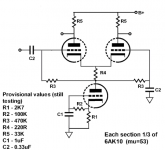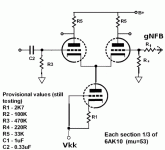This is just something I've been playing around with. I've never tried anything with a CCS before, and in this tube you get a third triode "for free". The mu of the tube seems high enough, for the CCS(ish) tail, I injected an AC signal at the plate and measured the AC impedance at around 30X the DC, so it's better than a resistor I guess.
The grid needs to be held near 0 (relative to cathode) to pass enough current to let the top pair work well. Most of the designs I found on the web use a divider between B+ and gnd to set this value. Are their any downsides to using the cathode to provide the ref V, like in the diagram?
It works OK with a constant amplitude sine wave, but I've not tried to hit it with any transients or such so I'm not sure this method of bias is stable.
Anything else I should try out?
Thanks...
The grid needs to be held near 0 (relative to cathode) to pass enough current to let the top pair work well. Most of the designs I found on the web use a divider between B+ and gnd to set this value. Are their any downsides to using the cathode to provide the ref V, like in the diagram?
It works OK with a constant amplitude sine wave, but I've not tried to hit it with any transients or such so I'm not sure this method of bias is stable.
Anything else I should try out?
Thanks...
Attachments
I wouldn't recommend anything like that. Triodes don't make very good CCSs. You'd be better off using two triodes as an LTP with a cascode of BJTs under the cathodes, and the third section as a pre to help make up for the half of the gain you lose with the LTP.
You could also consider the 6M11 -- two triodes and a pentode in the same bottle that could use the triodes as an LTP while the pentode serves as a CCS tail load. Pents aren't as desirable as active tail loads as they'll need a higher negative rail than will a solid state solution.
You could also consider the 6M11 -- two triodes and a pentode in the same bottle that could use the triodes as an LTP while the pentode serves as a CCS tail load. Pents aren't as desirable as active tail loads as they'll need a higher negative rail than will a solid state solution.
Miles,
I've seen designs like you describe, but I want to leave transistors out of it just for the sport. It seems good enough as it, the outputs are balanced within 1% so long as I don't load it too hard. I'm just not sure how it will behave faced with real music instead of a test signal.
On the other hand I could just stick a resistor on the tail and balance it by making the plate loads different, and then use the third tube for a preamp as you suggest. Maybe a better idea?
It's going to drive a PP (dual Pentode compactron of some sort) output stage, the idea is a "2 tube" mini-amp that puts out about 1 clean watt. Doesn't this mean full gain (1/2 pushing, 1/2 pulling) and not half gain? This point still confuses me, I've seen it stated both ways.
I've seen designs like you describe, but I want to leave transistors out of it just for the sport. It seems good enough as it, the outputs are balanced within 1% so long as I don't load it too hard. I'm just not sure how it will behave faced with real music instead of a test signal.
On the other hand I could just stick a resistor on the tail and balance it by making the plate loads different, and then use the third tube for a preamp as you suggest. Maybe a better idea?
It's going to drive a PP (dual Pentode compactron of some sort) output stage, the idea is a "2 tube" mini-amp that puts out about 1 clean watt. Doesn't this mean full gain (1/2 pushing, 1/2 pulling) and not half gain? This point still confuses me, I've seen it stated both ways.
If you still want to go that route, then may I suggest this (attached)?
Operating the triode off a negative rail will definitely help performance quite a bit. That also frees up the opposite side of the LTP for use as a feedback node. You could even add a pot there, and make the gNFB variable.
If all you need is ~1.0W, then maybe a 6360 might be a good choice? That's pretty much like having two 50C5's in one nine pin mini bottle (so far as PD us concerned). The 832A is another possibility, though over rated for such low power.
Operating the triode off a negative rail will definitely help performance quite a bit. That also frees up the opposite side of the LTP for use as a feedback node. You could even add a pot there, and make the gNFB variable.
If all you need is ~1.0W, then maybe a 6360 might be a good choice? That's pretty much like having two 50C5's in one nine pin mini bottle (so far as PD us concerned). The 832A is another possibility, though over rated for such low power.
Attachments
I've used a 6BH11 twin-triode+pentode successfully with the pentode as CCS. I didn't need a lot of voltage gain, so I can't comment on linearity at high output levels, but AC balance was excellent. Supply rails were +/-150V. I'll post more details if you wish.
On the other hand I could just stick a resistor on the tail and balance it by making the plate loads different, and then use the third tube for a preamp as you suggest. Maybe a better idea?
Yes, or you can use one tube as concertina PI and the other 2 as ltp or simply diff amp like in a Williamson.
The classic 2-tube amp would be 2 triode-pentodes where the pentodes form a PP final stage, one triode is a VA and one triode is concertina. Proven in many commercial designs and no need for 3 in 1 tubes or compactrons.
If you insist on leaving transistors out - then use a pentode for the CCS.
Seems like a lot of hard work for a worse result though.
Shoog
Seems like a lot of hard work for a worse result though.
Shoog
Thanks,
I'm going to try the negative rail ideas. Then some of the others. This is all on a breadboard so it's easy to try lots of things.
Basically this is kind of a "MacGyver" exercise (for those that remember the show). I've got a bunch of compactron triple-triodes I bought cheap on an impulse, and I'm trying to see what I can make out of them. They were cheap enough that if I burn up a few in the process of trying crazy stuff I don't need to shed any tears. If I were designing from scratch I get that there's a lot of better ways to do it.
(BTW, the cap marked 0.33uF in my diagram should be 0.033uF)
I'm going to try the negative rail ideas. Then some of the others. This is all on a breadboard so it's easy to try lots of things.
Basically this is kind of a "MacGyver" exercise (for those that remember the show). I've got a bunch of compactron triple-triodes I bought cheap on an impulse, and I'm trying to see what I can make out of them. They were cheap enough that if I burn up a few in the process of trying crazy stuff I don't need to shed any tears. If I were designing from scratch I get that there's a lot of better ways to do it.
(BTW, the cap marked 0.33uF in my diagram should be 0.033uF)
Anyway triode CCS has higher dynamic resistance than a plain resistor. It is a good option to use the tube.
Another option is, to use couple of triodes as a cascode, and the third one as a Concertina phase splitter.
One more option is, to use the first one as a Concertina, and 2 more triodes, as a directly coupled LTP with a resistor in the tail (or whatever you want to put there).
3 triodes is more than 2, and even more than 1, so it is flexible. ;-)
Another option is, to use couple of triodes as a cascode, and the third one as a Concertina phase splitter.
One more option is, to use the first one as a Concertina, and 2 more triodes, as a directly coupled LTP with a resistor in the tail (or whatever you want to put there).
3 triodes is more than 2, and even more than 1, so it is flexible. ;-)
Re Wavebourn's suggestion of a cascode...
I'll post a new thread when I've built things out enough to have something worth posting about, but so far the cascode idea seems to work out the best. Just with some casual fiddling around I'm getting 160X voltage gain at 2.1% THD. This is more than 4X the gain of the LTP, at 3X the distortion. Just rough measurements but the gain is pretty impressive, enough to use plenty of NFB if I go that route. This is the first time I've built one of these.
I'll post a new thread when I've built things out enough to have something worth posting about, but so far the cascode idea seems to work out the best. Just with some casual fiddling around I'm getting 160X voltage gain at 2.1% THD. This is more than 4X the gain of the LTP, at 3X the distortion. Just rough measurements but the gain is pretty impressive, enough to use plenty of NFB if I go that route. This is the first time I've built one of these.
- Status
- Not open for further replies.
- Home
- Amplifiers
- Tubes / Valves
- 6AK10 LTP with CCS question

